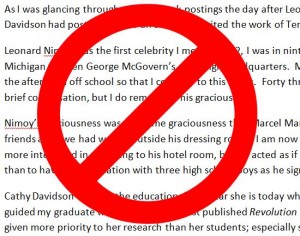Teaching Our Failures to Benefit Students
 Earlier today, I drafted an incredibly boring essay. There is a kernel of quality in the draft, but I will need to cut at least 75% of the text before I can hope to produce anything that I can publish.
Earlier today, I drafted an incredibly boring essay. There is a kernel of quality in the draft, but I will need to cut at least 75% of the text before I can hope to produce anything that I can publish.
I may—or may not—be able to salvage this essay. If it is salvaged, I will publish it in my blog and might cross post it on HASTAC. But what readers will not see is the 75% of prose that was cut; prose in which I come across as an insufferable name dropper who makes his reader slog through almost 700 words before he gets to his thesis.
I am not the least bit concerned about the bad prose I drafted. I have a folder of abandoned drafts on my computer; some of which I will return to and others that will rightly stay abandoned forever. All writers produce failed prose.
If I am able to salvage this morning’s essay, my students will likely benefit in one way that other readers will not. They will have the opportunity to read the insufferable draft.
We provide students with valuable insights about the writing process and help them gain critical thinking skills when we share our drafts with them. In addition to showing students drafts of my published writing, I will sometimes ask them to help me edit failed manuscripts to make them publishable. Students critique my work and help me to improve. By assisting me in editing my less than sterling drafts, they learn much about the editing process.
I first began sharing drafts with students when I was a graduate teaching assistant at Michigan State University. At that time, we used a technology called the mimeograph machine. I would write a paper along with my students by putting a purple ditto master in my typewriter on which I would type my manuscript. Because neither self correcting typewriters nor computers were readily available, it was not possible for me to edit while drafting; something I do today.
Once when I shared the purple text produced after taking the ditto master directly from typewriter to mimeograph machine to undergraduate class, one student commented, “You intentionally garbled this didn’t you.” My response: “No. This is what all my drafts look like.”
I am sure that I am not alone when I say that I don’t want most people to see drafts of my writing. However, I think it is important for students to see drafts; even those like this morning’s that are especially embarrassing.
- –Steven L. Berg, PhD
LEAVE A COMMENT